Tales From The
Crypt: GM X-Bodies
In recent years, the self-service wrecking
yard has been a haven for the do-it-yourselfer, since the individual would
salvage the needed component. Going to a "used auto parts" facility for
late model vehicles is a total dead end, since their inventory consist of newer
vehicles. There is one problem that is common with these yards:
vintage iron and/or classics often show up in the vehicle inventory, and to some
hobbyists, this can serve as an opportunity, and in some cases, a sad
sight.
I have been a veteran of the self-service
wrecking yards for a few years, since older vehicles serve as a "latinum mine"
for profit, as well as salvaging components that was not optioned on a typical
motor vehicle. HOT ROD Magazine (8/99) had an article on self-service
wrecking yards, and managed to snap a few pics of typical oldies and late model
vehicles. This might be a revelation of what the world of the self-service
wrecking yard is like, and any metropolitan area in the U.S. would have such a
facility.
What was covered in HOT ROD was the
Southern California scene, but here's another emphasis covered on this
page: the Third Coast, primarily Houston. Houston has the
Pick-A-Part chain (3 locations), Pick-N-Pull (Pasadena, TX), Take-A-Part &
Save (off Tanner Road), and Pull Your Part (Furay Avenue, south of East Mt.
Houston Road).
Here's a few pics that might bring a tear
to your eyes, or better yet, serve as a focal point in saving oldies from the
crusher. Most of the pics that I have taken involved the use of a
recyclable camera, since these are available at any department store. They
average around $4.00 -- $10.00, but I consider these cameras "Spy Cams."
This is like the microfilm cameras used by spies and government agents (a la
007). Note: some wrecking yard do not allow cameras inside the
compound, but the pics that you are about to see is horrifiying, and not
suitable for some web browsers.
The first page deals with the GM X-car
(Chevy II and Nova), and while browsing, feel free to have a look at the A-bodies section.
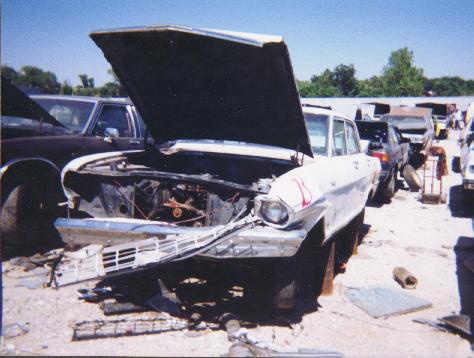
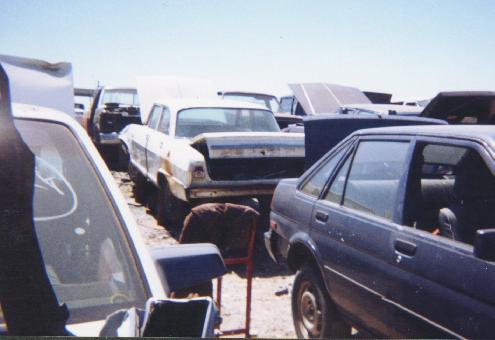
This 1964 Chevy II Nova 400
might have had a better life, if the front sheetmetal was replaced, but ended up
on jackstands instead. This car had the original 194 and Powerglide, and
when I returned to the same yard a week later, the interior was stripped bone
dry. I managed to pull the taillights and emblems, but someone had already
took the stainless trim around the taillights. A couple of weeks after
spotting the Chevy II, the LH front door was unscrewed off its hinges.
This car still had the OEM 13" rims and 5 lug hubs, which would be a perfect
candidate for upgrading earlier Chevy IIs. During another return trip,
someone hacked out the floorboard, since the floor sections were
rust-free. The second pic features a partial view of a Toy-let (a.k.a. a
Toilet or a commode), which is the ULTIMATE illegitimate offspring and a
descreation of the Nova marque. A few weeks after this pic was snapped,
the Nova was removed from the inventory and crushed. The same lot that
this pic was snapped had a 1960 Corvair sedan (yes, Corvairs also get crushed
and recycled), since self-service wrecking yards are known as "The Green Mile"
of automobiles.
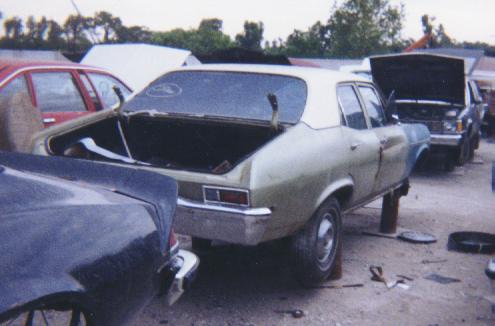
GM
manufactured more than 3,406,142 X-bodies (3,406,142 of them are Novas) from
1968 until 1979, and this 1968 Chevy II was stripped of its decklid and LH
taillight housing. The interior was gutted, and the instrument cluster
(unique to 1968 Chevy IIs/Novas) was gone when I spotted the car in the
yard. The other X-bodies seen in the background (the cars seen in the
background are Chevrolet Citations) are the fourth generation, which is a
illegitimate offspring of the RWD X-car. Here's another pic:
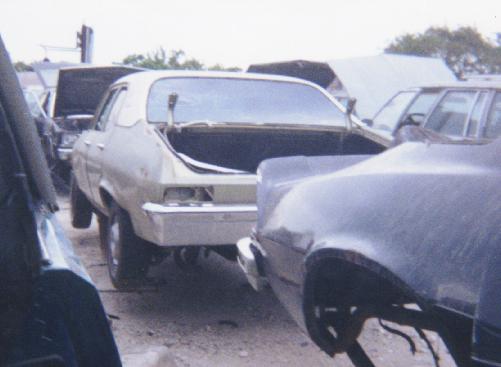
The LH
taillight housing was snatched, and inside the trunk was the front bumper.
The bumper was history, since the car was involved in a front-end
collision. I managed to pull the only remaining marker light in the
bumper, and a later revelation was that this Nova was a factory V8-powered car
(307). The frame towers for mounting the engine were still there, and this
might serve as a low-dollar alternative to locating V8 frame mounts for a first
genertion F-car of 1967-69 vintage (Camaro/Firebird).
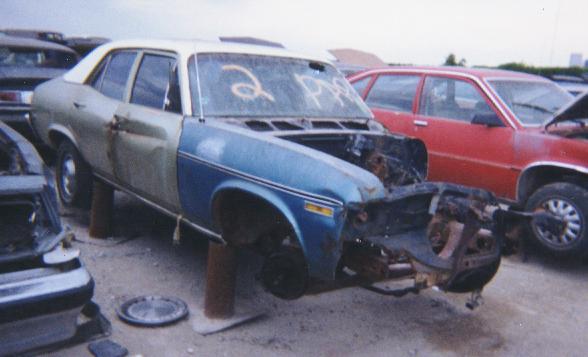
The Nova
had a 1970-74 RH fender, which is noted by the larger side marker. The
core support was bent, and if looking at the pic on the right, the car only had
a heater core, hence a non-A/C car. The subframe is straight, which makes
it a bolt-in for tri-year F-cars of 1967-69 vintage (the subframe from 1968-72
X-cars is a direct bolt-in). One thing about front subframes from GM
X-cars (as well as F-cars) is that they are popular with IFS conversions on
classic vehicles with a straight axle front suspenion, like early Chevrolet/GMC
pickups.

What
a sad sight. This 1973 Pontiac Ventura has a straight body, and a Code 17
bodystyle, which is known to X-car enthisiasts as the hatchback.
Unfortunately, the hatchback lid is rusted, but after looking inside the car,
the car was optioned with bucket seats. It's no rust bucket, and why it
ended up in the local Pick-A-Part is an uncertaintity. This might bring a
tear to someone's eye, when solid classics show up in the wrecking yard, only to
die a couple of months later. Next to the Ventura is an early 1970s Buick
Riviera, with the boattail rear section. The 455 in the Riviera was
pulled, and the body is all that's left. Like the other vehicles seen on
this page, this straight X-car met its fate with the crusher.
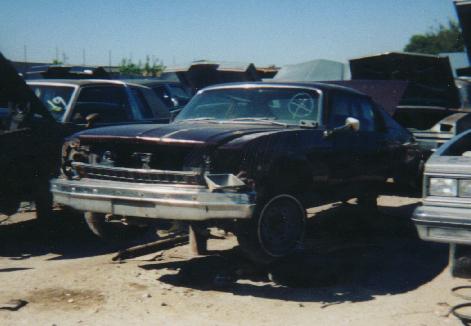
This is
a pic of a 1974 Nova, with a Disco-Era front clip. The front clip is from
a 1976 or 1977 Nova, and has the 1975-79 subframe in place of the original
rear-steer subframe. The pic is of poor quality, but should be viewable on
certain browsers. Mutant or a failed experiment from GM?
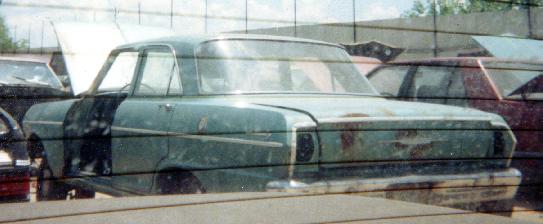
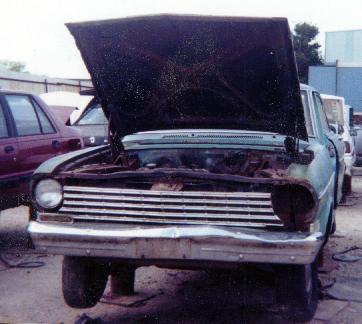
What a sad sight before
dying. When I came across this 1962 Chevy II 300 sedan, the LH door was
long gone, but the whole car would have been saved. The grille is from
either a 1963 or 1964, and after verifying the VIN, this was one of a few 1962
Chevy IIs still in existence today. There was a 194 motor underneath, but
before this Chevy II was put to death, the front grille, LH fender trim, quarter
panel emblems, and front fender trim pieces were salvaged by an Indiana
Jones-esque fortune hunter.
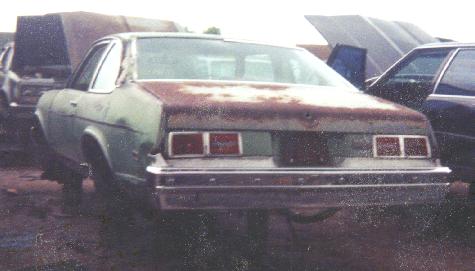
The
1975-79 generation is common in self-service salvage facilities, and one yard
(Pull Your Part) in the Houston area only saves the 2-door bodies. Not too
many people care about the 1975-79 generation, since there are no parts
available from the aftermarket, or considered a caste like 1973-77 GM
A-bodies. To purists, these X-cars are second-class rice burners, but made
in Detroit. When was the last time a 1976 Nova Medalist was painted
anything else but Olympic Gold?
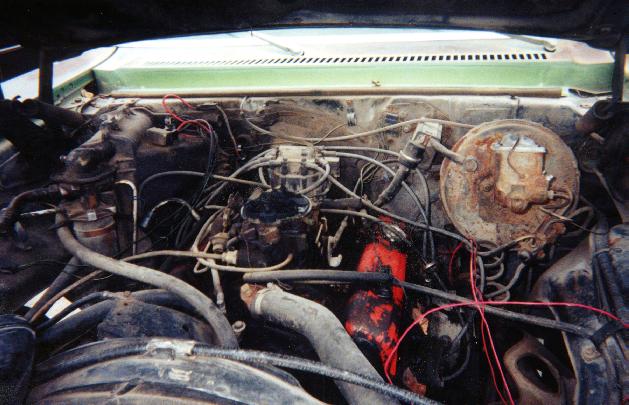
The Nova
seen in the above pic had a 350/350 drivetrain, but one thing unusual was a 7.5"
rear axle. Was this a 305 car, and became a 350? After I verified
the emissions label, this was an original 350 car, but why a 7.5" out
back? Go to this link for more
on the 1975-79 generation, or this page, if one goes to confession.
Copyright 1999, 2000 LSC Publications. All Rights
Reserved. Feel free to borrow the images, and hope that classics shouldn't
end up in a salvage facility like Pick-A-Part. This is a nightmare, and
should be eliminated. For more info, contact COVA/CVAG.
Yard
Tips
The Death Penalty --
Classic A-Bodies
Accessed  times
times





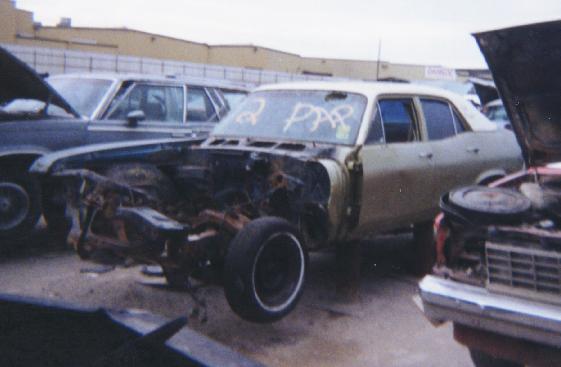






times